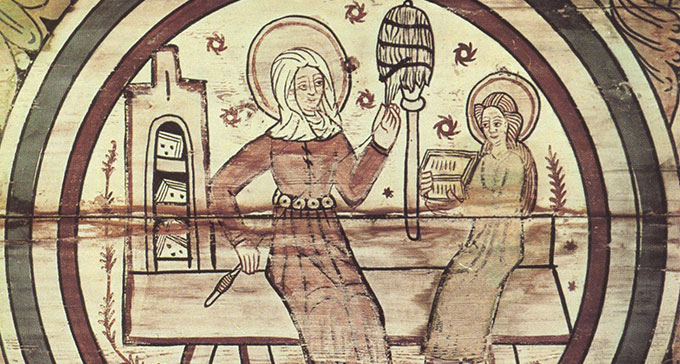
How are ballads narrated?
Objective accounts of the course of events, devoid of value judgements, are characteristic of the narrative technique of the ballad. Bengt R Johnson and Margareta Jersild describe this technique in Svenska visor – en vägledning:
”In spite of the highly variable contents of various ballads, they all display a common literary technique. The tale is always told by an objective narrator who never stoops to making comments. The main roles are characterised by their deeds and words. Conversations between persons often take place, and these dialogue stanzas are sometimes joined two by two as parallel stanzas. The narrator is also inevitably someone completely outside the action. No ‘I’ is present, except in quotations or refrains.”
The action is often set in a number of scenes, the various parts of the tale taking place in different locations. These locations can have a number of predetermined connotations and associations. Some examples:
- Rosende lund [rosy grove] is a place outside the estate or village where unknown persons are present, a place in which threatening or decisive events often take place.
- Sjöastrand [sea strand] is also a risky place, between land and sea.
- Högan loft [high gallery] is the place where well-born persons sit on a large or royal estate, able to see what happens outside.
- Frustugan [lady’s bower] and jungfruburen [maiden’s bower] are separate chambers for women in a noble home.
Often the place or scene is briefly described first, then the story progresses via either a dialogue between the main characters or a description of events.
Stylising and formulas
The language is stylised: a repertoire of stock phrases (commonplaces) or formulas recur in different ballads; they can be combined in a number of ways to tell different tales. Apart from – as seen above – indicating particular places, the formulas can for example tell of a person’s appearance and social standing: ”snövitan hand” (snow-white hand) refers to one of the gentry – they need not work with their hands – as does ”svept i mård” (clad in a fine pelt). ”Klädd i vadmalet grå” (clad in grey homespun) refers, however to woollen garments normally worn by poor working persons.
Formulas can also describe a gesture with a certain meaning: a woman who ”kammar sitt hår” (combs her hair) outdoors is displaying her beauty and seeking a suitor. Someone who ”axlar sitt skinn” (shoulders his pelt) is putting on outdoor clothes, ready to set off and perform some act. To ”skaka sitt blodiga svärd” (shake your bloody sword) is of course a threatening gesture, whilst ”klappa på bolstren blå” (pat the bolster blue) is an invitation to more or less intimate relations. The question ”Vad fick du för äran din?” (what price was your honour) refers to possible material compensation for a seduction – or for a rape; these distinct ways to lose one’s virginity converge in the world of ballads. Gifts are often mentioned as ”guldringar” (gold rings), ”röda gullband” (red-gold ribbons) or ”ett gångande skepp uti floden” (a rolling ship on the river).
Persons and milieu
The ballads originate from the culture of the medieval continental wellborn, but fairly soon became a popular form of expression. The culture of the nobility manifests itself, for example, in milieu-related terms such as ”högan loft” (high gallery), ”jungfrubur” (maiden’s bower) and ”rosende lund” (rosy grove) or in clothing – for example, ”skarlakan” (scarlet cloth), “sobel” (sable) and ”silkeskjortel” (silken mantle). Other signals might be fine horses (gångare grå), drinks such as mead and wine and, not least, the titles of persons. The men might be called Herr (Lord) Peder, Herr Olof or Herr Sven and the women Jungfru (Maid) Lena, Fru (Lady) Margareta or stolts (proud) Elin. These titles indicate that their bearers are members of the nobility or gentry. Liten (little) Karin is, in contrast, from a lower class – a farmer’s daughter or a maid. A poor man might appear without a name, called merely ”fanteguten” (tramp), ”bonden” (the peasant) or ”vallaren” (the herder). A poor woman might be referred to simply as ”vallpigan” (the herding girl).
The jocular ballads are in particular set in simpler environments, and often concern food and drink, the burlesque, bodies and sexuality – or cheating the higher-ups. They might portray the ”world turned upside-down” with the logic of the carnival – a wife might beat her husband – or tell of where ”laxen han klättrar i eketopp å rister ner stora lövgrenar / och ekorrn han springer på havsens bott och vältrar opp stora grå stenar” (the salmon he climbs to the top of the oak and shakes down big leafy branches/ and the squirrel runs on the sea bed and rolls up big rocks). In jocular ballads, it is also common for animals to act – as in ”Bonden och kråkan” (the farmer and the crow) or ”Tordyvelns bröllop” (the dung-beetle’s wedding).
Read more:
Svenska visor
Den norske balladen
Bengt R. Jonsson: Inledning in Svenska medeltidsballader. Stockholm: Natur & kultur 1981.


Kommentarer